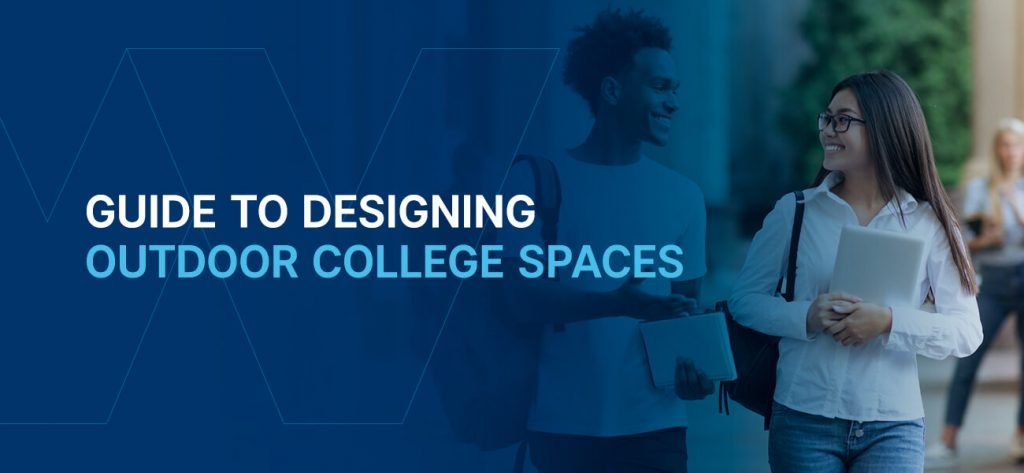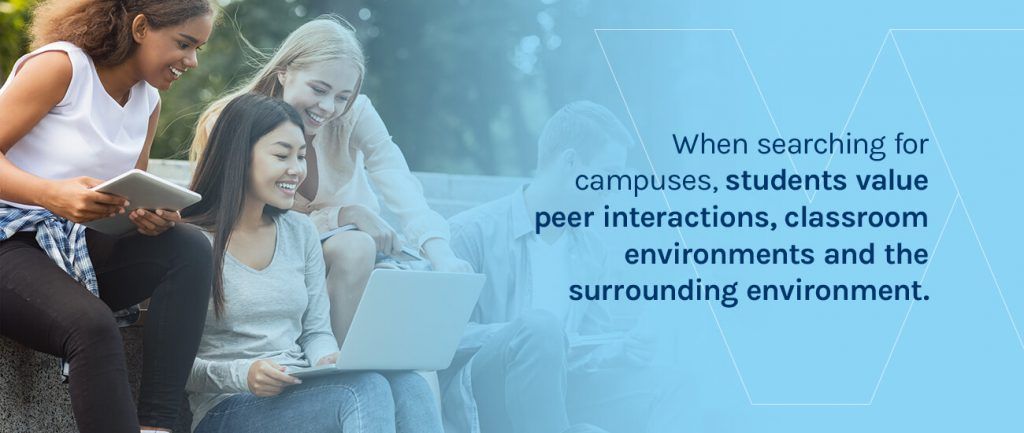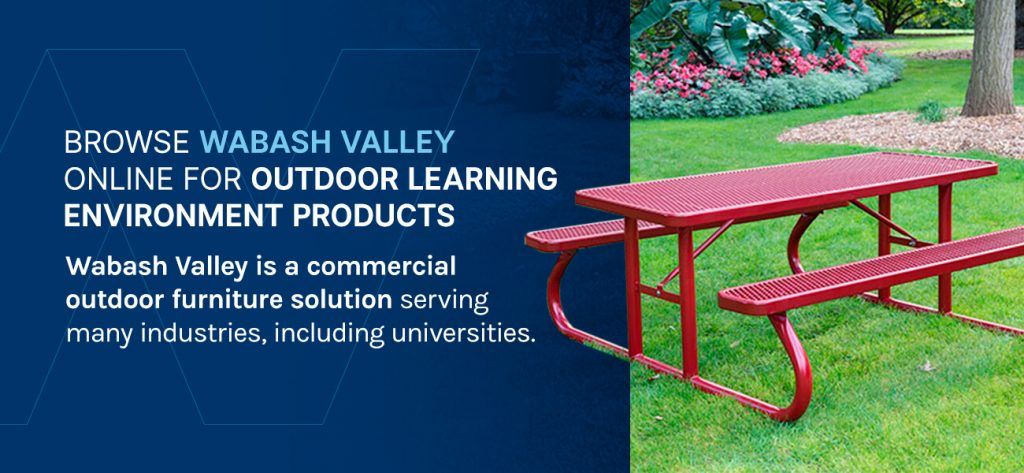Guide to Designing Outdoor College Spaces

Articles | Apr 22, 2021
Urban designs have hundreds of years worth of progress behind them. We aren’t living in caves or clay houses anymore — today, we admire modern, steel-and-glass buildings hundreds of stories tall.
It’s time to see the same level of change in our academic settings. Architects are now challenging the traditional layout of college campuses with outdoor learning environments. Continue reading to discover how outdoor learning environments can benefit your college, along with tips on how to integrate them into your campus.
- What Is an Outdoor Learning Space?
- The Trend of Outdoor College Learning Environments
- Benefits of Outdoor Spaces at Universities
- Tips for Designing Your Outdoor College Spaces
- Steps for Designing Outdoor Spaces
- FAQs About Outdoor Learning Spaces
- Browse Wabash Valley Online for Outdoor Learning Environment Products
What Is an Outdoor Learning Space?
Outdoor learning spaces are any outdoor environments used to enhance students’ education. These can include outdoor classrooms equipped with a whiteboard and desks or more natural environments like community gardens or arboreta. Professors can bring their classroom outside, or students can facilitate independent learning by engaging with structured tools.

The Trend of Outdoor College Learning Spaces
Traditionally, we think of outdoor spaces as places to relax and enjoy nature. In a college setting, students may use outdoor spaces to play games like Frisbee. Conventional wisdom says most learning takes place inside. Current trends are challenging these historic limitations, suggesting that bringing classes outdoors leads to better student success.
The effects of the COVID-19 pandemic ignited the current trend of outdoor learning environments at college. Most campuses closed or limited classroom learning because of the inability to practice safe social distancing. Some professors moved their classes outside for more flexibility and room to spread out.
Outdoor college spaces are more than a trend. They’re an opportunity to encourage better academic behaviors, inclusivity and participation, and build a stronger sense of community.
Benefits of Outdoor Classroom Spaces at Universities
Consider these benefits of college outdoor learning spaces.
1. Sustainability and Lower Costs
Indoor college spaces require a lot of resources. Buildings can cost at least hundreds of dollars per square foot of university space — that adds up to hundreds of thousands of dollars. Administrators can also expect to pay for water, heating and cooling, lighting, electricity and other expenses.
Comparatively, outdoor educational spaces require exterior furniture and technology like projectors, internet and outlets. For other outdoor spaces, like gardens, all you’ll need is low-price items like gardening tools or seeds.
These costs are far less than indoor college spaces. While outdoor college areas won’t eliminate the need for indoor spaces, they may be a financially viable solution when expanding your campus.

2. Attractive to New Students
Colleges spend multiple millions of dollars on annual advertising to attract new students. Marketing to new students brings in a higher student population, building a better brand image and financially supporting campus operations.
When searching for campuses, students value peer interactions, classroom environments and the surrounding environment. However, not all campuses are maximizing opportunities for outdoor learning. Designing classrooms outside gives your campus a competitive advantage, attracting students with the spaces’ social abilities, unique classroom environment and campus amenities.
3. Greater Student Success
Outdoor campus environments can be equally beneficial to students as indoor learning environments. They meet many of the same benefits as these indoor spaces and provide further advantages like the positive effects of nature and a refreshingly new learning environment. More specifically, outdoor spaces allow educators to implement new education strategies using flexible design elements, enabling new group behaviors for better performance.
4. Instills Feelings of Safety
Students reach higher academic achievement and engage more fully in their studies when they feel safe in their learning environment. When students feel unsafe, they can’t concentrate during class or might refuse to go, adversely affecting their GPA. Considerately designed outdoor learning spaces make students feel safe. Create outside classrooms in a central campus location with high visibility, excellent lighting and ample sanitization stations.

5. More Inclusive
Multicultural placemaking is a design concept that strategizes architectural elements to make students of all backgrounds feel comfortable. This concept is especially relevant in campus environments, which attract students from different backgrounds and heritages. Inclusivity ties directly into safety — when students feel included, they’re more likely to trust their peers and feel safe in their educational space.
Make your outdoor learning environment feel inclusive by taking the following steps.
- Survey your population for student needs: Get to know your student population’s needs by asking them. Learn your students’ varying abilities, gender identity, unique culture, etc. With this information, you gain a foundation on what they need to feel included.
- Provide flexible seating: Flexible seating allows students to take control of their learning environment. Make seating feel inclusive by grouping tables and desks together, rather than isolating them.
- Celebrate cultural differences: Hang student artwork and incorporate other culturally appropriate designs into your outdoor learning environment. Also, ensure students of all abilities have access to your classroom and can easily navigate the space.
6. Higher Interaction
Many benefits of outdoor learning spaces — exposure to nature’s positive effects, feelings of safety and inclusivity, among others — lead to higher interaction and engagement rates. Students will want to use these spaces for self-directed learning. They can also take advantage of these for more than classroom purposes, like social interaction or study groups. All of these behaviors are influential to student success.
Outdoor College Classroom Design Tips
When designing your outdoor college spaces, here are some tips to consider.

1. Strategize Classroom Design
Excellent classroom design encourages passive and active learning — that is, equipping students with tools for success, and making those feel inviting enough to make students want to use them.
Traditionally, indoor classroom environments are fully enclosed rooms with a mounted screen or whiteboard in front of a row of desks. The educator stands in front of the classroom and administers a lecture-based lesson plan. Architects are beginning to second-guess this design, brainstorming ways to make learning more effective.
Strengthen your outdoor classroom by outfitting it with flexible, multipurpose furniture, or furniture that adapts to a group’s or individual’s task.
Spaces with flexible furniture encourage group work, discussion, collaboration and engagement. Multiply these benefits by combining them with the advantages of being outside, including improved mood, lower stress, higher self-confidence, and more peer support.
2. Consider the Benefits of Social Spaces
Outdoor educational spaces have two goals — to support students academically and encourage socialization. Students regularly engage in on-campus academics and socialization, which are both integral to student success. Social spaces bridge the gap between academic and personal lives. Social spaces allow students to:
- Collaborate with peers.
- Recharge between classes or activities.
- Feel connected to the community.
- Showcase their culture.
Whether studying in groups or socializing between classes, students will naturally look for a place to congregate. Campuses should provide students with gathering spots that don’t interfere with academic-specific spaces, like quiet libraries.
Design your outdoor learning space to accommodate academic and social needs. For campus administrators, consider dedicating one group of outdoor spaces for first-come, first-served purposes, and another group with a signup policy for students or professors to reserve “rooms.”
3. Display Artwork Historic Features to Attract Foot Traffic
Urban intervention is a design concept that transforms empty spaces into something useful for the environment. In outdoor academic settings, this includes the following.
- Artwork: Artwork attracts the eye and brings personality to a space. Examples of artwork that can add value to your outdoor learning environment are student creations, like framed photographs, painted canvases or sculptures.
- Historic features: History blends past and present, adding context and character. It showcases growth and potential, attracting people with a sense of school pride. Examples of historic features are trophies, awards and old photographs.
- Flexible furniture: As mentioned, flexible furniture is multi-use furniture students can manipulate to make activities more efficient. Examples include movable chairs and tables or storage areas.
Art and historic features attract foot traffic to the outdoor space. Flexible furniture is attractive and keeps students engaged. Having all three features attracts students and encourages student success.

4. Intertwine Campus Branding Strategies
Your university story and personality should resonate throughout all aspects of your campus, including in your outdoor learning spaces. You can intertwine campus branding strategies — like your university’s colors, mascot, logo and symbols — by using brand-colored furniture, decorating with historic photos of previous students and adding your university’s logo somewhere in your design.
Consider these benefits of a well-branded campus.
- Competitive advantage: What brand qualities set you apart from your competitors? Highlight this competitive advantage throughout your outdoor educational space design.
- More loyalty: A strong brand leads to higher brand recognition, resulting in more enthusiastic student commitment. And, when students feel loyal to their university, they’re more likely to donate resources after graduation.
- Enhanced credibility: A college education is an investment. Make people feel more confident in their choice by boosting your credibility.
5. Tailor to Different Student Personalities
Students have different working personalities. Here are some student learning styles you’ll want to consider when designing outdoor college spaces.
- Visual: Visual learners absorb information better when their instructor presents it in an engaging format that includes pictures, charts and diagrams.
- Auditory: Auditory learners respond well to presentations like speeches and lectures. These students may be musically inclined, with an innate sense of rhythm.
- Verbal: Verbal learners tend to have expansive vocabularies and usually enjoy reading and writing. They have little trouble expressing their thoughts in essay format and may excel in debating, speechwriting or journalism.
- Physical: Physical, or kinesthetic, learners are gifted natural athletes who prefer to learn by doing. Touch and feel are essential to these students, who retain information best through hands-on experimentation.
These learning styles benefit from flexible furniture. Contribute to these workstyles by making your outdoor workspace both functional and social.
Steps for Designing Outdoor Learning Spaces
Jump-start your outdoor college space design by following these steps.

1. Survey Your Campus Population
Outdoor spaces vary from university to university depending on the population’s unique needs. Survey your campus population, including students and faculty, to know what’s currently working and what needs improvement.
Many campuses survey their students to analyze their curriculum. Along with these academic-based surveys, solicit opinions about your university’s school environment. We know that the school environment is a crucial factor for prospective students, and current students value the university environment, too.
Ask students how they use their resources. Look at which spaces they’re using and how. Are there any areas they don’t use? If so, why do they avoid these?
Allow anonymous responses, so your students feel more comfortable offering their genuine opinions. Survey your population frequently as you make changes. That way, you can easily identify which change makes the most significant impact. Continue surveying after building your outdoor space and make periodic changes to maximize space efficiency as student needs change.

2. Determine Campus Strengths and Weak Spots
Using your survey results, determine your campus’ strengths and weaknesses. Your strengths will identify your population’s personality types. Specifically, it will highlight things your students value, like independent work areas or places for group work. Your weaknesses will show you two things — what students don’t need, and anything they’d use that they currently lack.
Use this information to:
- Incorporate your strengths into your outdoor space design.
- Avoid integrating resources your students don’t need.
- Provide a solution for things that your population wants but isn’t currently receiving.
3. Find the Right Location
Strategically place your outdoor learning environments on your campus. Study the current navigational flow and plan a location that’s easily reachable for students and faculty. Examples of places around your campus that may best serve outdoor learning environments are near community spaces, like dorms or cafeterias, or other educational buildings.

4. Design and Create Your Outdoor Space
The most significant step in creating your outdoor space is bringing your design to life. Here are some design elements you may consider implementing into your outdoor learning environment.
- Student artwork: Work with your art department and showcase students’ works in your outdoor learning space.
- Memorabilia: Incorporate historical elements by adding memorabilia to your design. For example, in your community garden, talk about how many people the garden has fed or include memorial benches for past donators.
- Flexible furniture: For classroom environments, incorporate flexible furniture that classes and groups can easily manipulate. Some furniture you may consider adding are picnic tables, outdoor benches and game tables.
- Trash receptacles and other necessities: Every outdoor space needs shared stapleslike trash receptacles, benches, bike loops and so on.
- Electronics: Think about how people will engage with your outdoor learning environments. Most outdoor environments will require technologies like outlets or an internet connection.
- Branding: Communicate your brand by strategically adding colors, logos and symbols to your outdoor space.
5. Market Your Space With Signage
Signage is a crucial part of all aspects of your campus. Signage fulfills the following roles.
- Guides visitors and students through the campus: Trying to navigate an unfamiliar campus without signage is challenging. Directional guides tell students and faculty where to go, so they don’t spend hours wandering the campus.
- Increases understanding of the area: Informational signage, like maps or directories, tells people which building has the classroom or resource they need.
- Shares essential updates and information: Signage can tell people how to interact with your outdoor educational space. That way, you avoid any confusion or misuse.
Examples of signage you can include in or around your outdoor educational space are wayfinding signs, maps, directional arrows and entrance signs. Signs are also excellent opportunities to incorporate branding strategies, like using your university’s colors or logo.
FAQs About Outdoor Learning Spaces
Here are answers to some lingering questions you may have about designing outdoor college spaces.
How Much Does It Cost to Build an Outdoor Learning Space?
Outdoor learning spaces will vary in cost. For example, a community garden will cost far less than an outdoor classroom equipped with furniture and technology.
In general, you can expect to pay at least a few thousand dollars, potentially exceeding tens of thousands of dollars with labor costs. Compared to the hundreds of thousands of dollars it takes to build a new building on campus, creating an outdoor learning environment may be the most economically conscious decision for your university.
How Do You Start an Outdoor School Program?
Start an outdoor school program by following these steps.
- Do your research: Survey your student population and see what they’re interested in. Administer an anonymous survey so students feel more comfortable voicing their honest opinions.
- Identify which outdoor program is best for your campus: Analyze the results of your survey.Find what works for your population. If your campus is more rural or has a well-known agricultural program, your students may enjoy a greenhouse or community garden. Or, if your student population thrives with group-based discussion, they may prefer reservable outdoor classroom spaces.
- Design your outdoor space: Once you’ve determined which space your population will most enjoy, design your outdoor space following the tips outlined above.
- Advertise your outdoor space: Promote your outdoor school program by making announcements, sending educational emails and adding signage throughout your campus.
What Should Be in an Outdoor Classroom?
At a minimum, equip your outdoor classroom with these basics.
- Seating: Students and faculty will need a place to sit when working on projects or communicating with peers. Arrange seating in groups to facilitate discussion.
- Tablespace: Along with seating, users will require a surface to work on. Consider placing maneuverable tablespaces so students can adjust their work area or fixed solutions to avoid theft.
- Signage: Direct your campus population to your outdoor classroom using signage. Within your outdoor classroom, include signage that informs users how to best interact within the space.
- Artwork or historic memorabilia: Spark interest and attract attention to your outdoor classroom by adding artwork or nostalgic items.
- Internet connection: Some students may want to use their mobile technology to benefit their studies. Allow for technology use by installing a reliable internet connection.
- Trash receptacles: Ensure people can considerately take care of your outdoor classroom by adding a trash receptacle to the area.
- Sanitization stations: The COVID-19 pandemic has led people to take more precautions against germs and other hazards. Make students feel safe by adding sanitization stations to your outdoor classroom.

Browse Wabash Valley Online for Outdoor Learning Space Products
Wabash Valley is a commercial outdoor furniture solution serving many industries, including universities and other higher education institutions. Outdoor learning spaces are great opportunities for your campus to better serve your population and foster higher academic success. These educational spaces benefit you, too, with lower costs compared to larger indoor structures.
When outfitting your outdoor learning space, contact Wabash Valley with your questions about design processes or learn more about our products by browsing online.
Categories
Recent Posts
Sign up for our newsletter
Share this post: